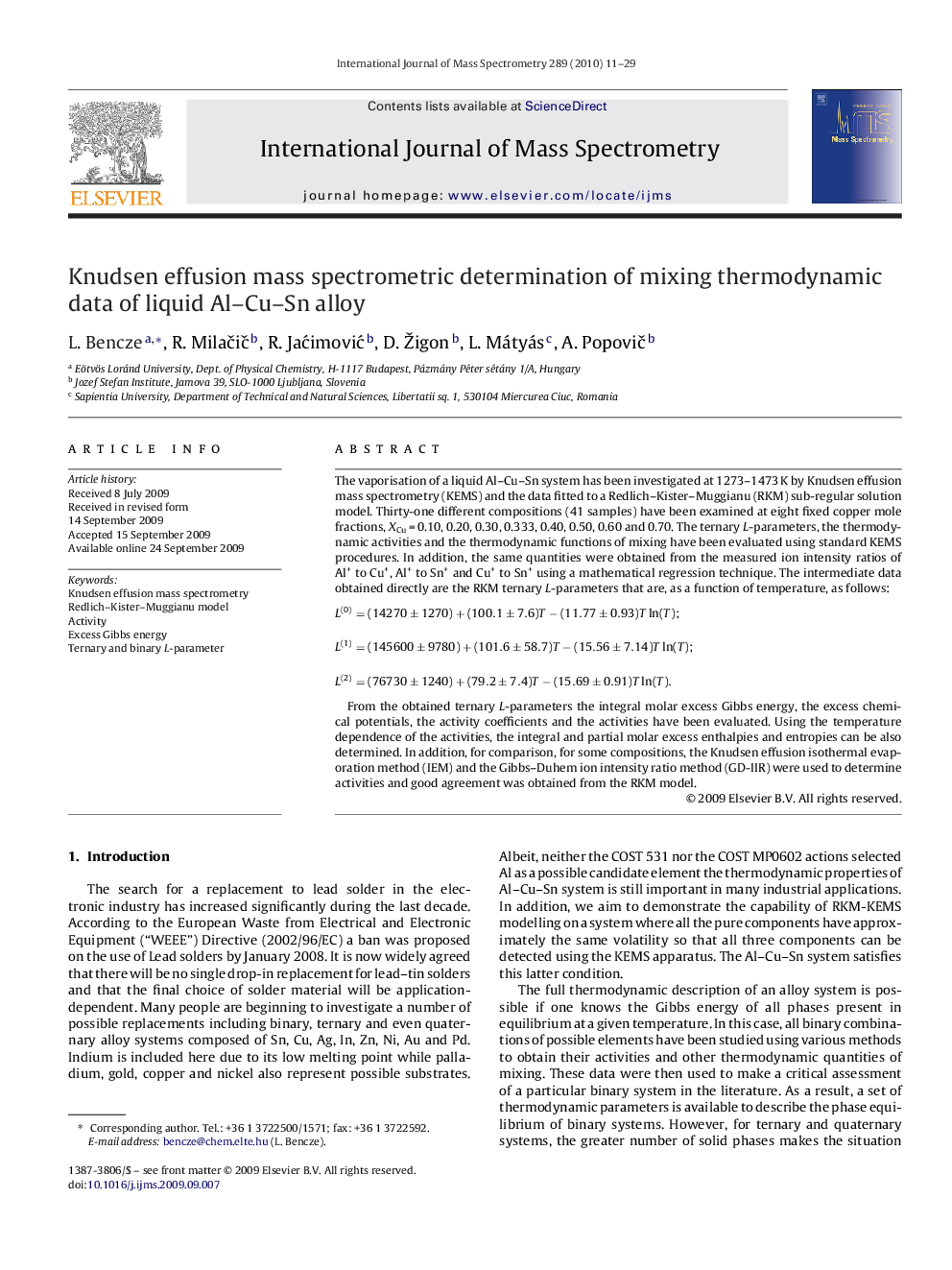| Article ID | Journal | Published Year | Pages | File Type |
|---|---|---|---|---|
| 1193916 | International Journal of Mass Spectrometry | 2010 | 19 Pages |
The vaporisation of a liquid Al–Cu–Sn system has been investigated at 1273–1473 K by Knudsen effusion mass spectrometry (KEMS) and the data fitted to a Redlich–Kister–Muggianu (RKM) sub-regular solution model. Thirty-one different compositions (41 samples) have been examined at eight fixed copper mole fractions, XCu = 0.10, 0.20, 0.30, 0.333, 0.40, 0.50, 0.60 and 0.70. The ternary L-parameters, the thermodynamic activities and the thermodynamic functions of mixing have been evaluated using standard KEMS procedures. In addition, the same quantities were obtained from the measured ion intensity ratios of Al+ to Cu+, Al+ to Sn+ and Cu+ to Sn+ using a mathematical regression technique. The intermediate data obtained directly are the RKM ternary L-parameters that are, as a function of temperature, as follows:L(0)=(14270±1270)+(100.1±7.6)T−(11.77±0.93)T ln(T);L(0)=(14270±1270)+(100.1±7.6)T−(11.77±0.93)T ln(T);L(1)=(145600±9780)+(101.6±58.7)T−(15.56±7.14)T ln(T);L(1)=(145600±9780)+(101.6±58.7)T−(15.56±7.14)T ln(T);L(2)=(76730±1240)+(79.2±7.4)T−(15.69±0.91)T ln(T).L(2)=(76730±1240)+(79.2±7.4)T−(15.69±0.91)T ln(T).From the obtained ternary L-parameters the integral molar excess Gibbs energy, the excess chemical potentials, the activity coefficients and the activities have been evaluated. Using the temperature dependence of the activities, the integral and partial molar excess enthalpies and entropies can be also determined. In addition, for comparison, for some compositions, the Knudsen effusion isothermal evaporation method (IEM) and the Gibbs–Duhem ion intensity ratio method (GD-IIR) were used to determine activities and good agreement was obtained from the RKM model.
Graphical abstractThe vaporisation of a liquid Al–Cu–Sn system has been investigated at 1273–1473 K by Knudsen effusion mass spectrometry (KEMS) and the data fitted to a Redlich–Kister–Muggianu (RKM) sub-regular solution model. Thirty-one different compositions (41 samples) have been examined at eight fixed copper mole fractions, XCu = 0.10, 0.20, 0.30, 0.333, 0.40, 0.50, 0.60 and 0.70. The ternary L-parameters, the thermodynamic activities and the thermodynamic functions of mixing have been evaluated using standard KEMS procedures. In addition, the same quantities were obtained from the measured ion intensity ratios of Al+ to Cu+, Al+ to Sn+ and Cu+ to Sn+ using a mathematical regression technique. The intermediate data obtained directly are the RKM ternary L-parameters that are, as a function of temperature, as follows:L(0)=(14270±1270)+(100.1±7.6)T−(11.77±0.93)T ln(T);L(0)=(14270±1270)+(100.1±7.6)T−(11.77±0.93)T ln(T);L(1)=(145600±9780)+(101.6±58.7)T−(15.56±7.14)T ln(T);L(1)=(145600±9780)+(101.6±58.7)T−(15.56±7.14)T ln(T);L(2)=(76730±1240)+(79.2±7.4)T−(15.69±0.91)T ln(T).L(2)=(76730±1240)+(79.2±7.4)T−(15.69±0.91)T ln(T).From the obtained ternary L-parameters the integral molar excess Gibbs energy, the excess chemical potentials, the activity coefficients and the activities have been evaluated. Using the temperature dependence of the activities, the integral and partial molar excess enthalpies and entropies can be also determined. In addition, for comparison, for some compositions, the Knudsen effusion isothermal evaporation method (IEM) and the Gibbs–Duhem ion intensity ratio method (GD-IIR) were used to determine activities and good agreement was obtained from the RKM model.Figure optionsDownload full-size imageDownload as PowerPoint slide
